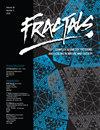多孤子,分岔,混沌模式和裂变/聚变,双分量扩展(2+1)-d itÔ微积分系统的异常波解
IF 2.9
3区 数学
Q1 MATHEMATICS, INTERDISCIPLINARY APPLICATIONS
Fractals-Complex Geometry Patterns and Scaling in Nature and Society
Pub Date : 2023-11-11
DOI:10.1142/s0218348x23501359
引用次数: 0
摘要
对非线性现象的探索需要对具有时空变量的复杂系统的表示,在这条线上,Itô微积分,作为与变量公式和链式规则相关的变化的随机微积分版本,涉及f的二阶导数,来自布朗运动具有非零二次变化的性质。为此,扩展的([公式:见文本])二维双分量Itô方程作为本研究中使用的一种适用的数学工具,可以增强我们对多维物理系统中固有的复杂动力学的理解,它可以用于建模和理解遍及各个学科的动态现象。对于复杂现象的建模,分数阶微分方程(FDEs)、常微分方程(ode)、偏微分方程(PDEs)以及其他方法在准确性和可操作性方面都具有优势。因此,我们的研究提供了使用Hirota双线性方法对双分量非线性扩展([公式:见文本])维Itô方程的分析,以导出多个孤子解,包括新的变化及其色散系数,这揭示了Itô方程的有趣属性。研究进一步涵盖了不同类型的孤子,如一般的一阶孤子、具有裂变和分岔的二阶孤子、三阶孤子和具有裂变和分岔的四阶孤子。除此之外,本研究还通过改变不同平面上的参数来探索异常波和块解。因此,这些结果验证了双分量非线性扩展([公式:见文本])维Itô方程及其与相关系统的相关性的特性和效用。通过分析,从理论和实验两个方面揭示了基于Itô微积分系统的新发现,并结合图形表示了参数对孤子的影响,与分析结果一致。这些增强了对由双分量非线性扩展([公式:见文本])维Itô方程控制的复杂属性的动力学的理解,特别是关于混沌模式,裂变和分岔孤子非线性复杂性。本文章由计算机程序翻译,如有差异,请以英文原文为准。
MULTIPLE SOLITONS, BIFURCATIONS, CHAOTIC PATTERNS AND FISSION/FUSION, ROGUE WAVES SOLUTIONS OF TWO-COMPONENT EXTENDED (2+1)-D ITÔ CALCULUS SYSTEM
The exploration of nonlinear phenomena entails the representation of intricate systems with space-time variables, and across this line, Itô calculus, as the stochastic calculus version of the change pertaining to the variables formula and chain rules, involves the second derivative of f, coming from the property that Brownian motion has non-zero quadratic variation. To this end, the extended ([Formula: see text])-dimensional two-component Itô equation, as an applicable mathematical tool employed in this study for enhancing our understanding of the complex dynamics inherent in multidimensional physical systems, serves the purpose of modeling and understanding dynamic phenomena pervading various disciplines. For modeling complex phenomena, fractional differential equations (FDEs), ordinary differential equations (ODEs), partial differential equations (PDEs) as well as the other ones provide benefits in terms of accuracy and tractability. Accordingly, our study provides the analysis of the two-component nonlinear extended ([Formula: see text])-dimensional Itô equation using the Hirota bilinear method to derive multiple soliton solutions, including novel variations along with their dispersion coefficients, which shed light into the intriguing attributes of the Itô equation. The investigation further encompasses diverse soliton types, such as the general first-order soliton, second-order soliton with fission and bifurcation, third-order soliton, and fourth-order soliton with fission and bifurcation. Besides these, the study also explores the rogue wave and lump solutions by varying parameters across distinct planes. Consequently, these results validate the characteristics and utility of the two-component nonlinear extended ([Formula: see text])-dimensional Itô equation and its relevance to related systems. The novel findings based on the Itô calculus systems revealed, through the analyses, theoretical and experimental aspects in combination with the graphical presentation of the parameter effects on solitons in line with the analyses obtained. These have enhanced the understanding of the dynamics of intricate attributes governed by the two-component nonlinear extended ([Formula: see text])-dimensional Itô equation, particularly concerning chaotic patterns, fission and bifurcation soliton nonlinear complexities.
求助全文
通过发布文献求助,成功后即可免费获取论文全文。
去求助
来源期刊
CiteScore
7.40
自引率
23.40%
发文量
319
审稿时长
>12 weeks
期刊介绍:
The investigation of phenomena involving complex geometry, patterns and scaling has gone through a spectacular development and applications in the past decades. For this relatively short time, geometrical and/or temporal scaling have been shown to represent the common aspects of many processes occurring in an unusually diverse range of fields including physics, mathematics, biology, chemistry, economics, engineering and technology, and human behavior. As a rule, the complex nature of a phenomenon is manifested in the underlying intricate geometry which in most of the cases can be described in terms of objects with non-integer (fractal) dimension. In other cases, the distribution of events in time or various other quantities show specific scaling behavior, thus providing a better understanding of the relevant factors determining the given processes.
Using fractal geometry and scaling as a language in the related theoretical, numerical and experimental investigations, it has been possible to get a deeper insight into previously intractable problems. Among many others, a better understanding of growth phenomena, turbulence, iterative functions, colloidal aggregation, biological pattern formation, stock markets and inhomogeneous materials has emerged through the application of such concepts as scale invariance, self-affinity and multifractality.
The main challenge of the journal devoted exclusively to the above kinds of phenomena lies in its interdisciplinary nature; it is our commitment to bring together the most recent developments in these fields so that a fruitful interaction of various approaches and scientific views on complex spatial and temporal behaviors in both nature and society could take place.

 求助内容:
求助内容: 应助结果提醒方式:
应助结果提醒方式:


